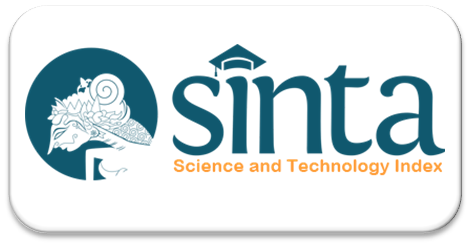The Influence of Diet on Overweight Status in Adolescent Students of SMK Muhammadiyah 3 Purwokerto
DOI:
https://doi.org/10.35960/vm.v18i1.1655Keywords:
Student Eating Patterns, Overweight StatusAbstract
According to SIRKESNAS 2022, in Indonesia, 13.5% of individuals aged 18 years experience excess weight, with 28.7% being overweight with a BMI of 25 and around 15.4% being overweight with a BMI of 27. Being overweight is a condition where body weight exceeds normal levels and can be caused by excessive eating patterns, such as fast food and junk food. The study aims to determine the effect of eating patterns on adolescents' overweight status. This quantitative study used an analytical observational method with a cross-sectional design. The sample consisted of 225 Vocational High School (SMK) Muhammadiyah 3 Purwokerto students, selected through cluster random sampling. The data used in this study included questionnaires on eating patterns and measurements of weight, height, mid-upper arm circumference, and waist circumference to assess overweight status. The eating pattern questionnaire comprised 20 items, of which 17 were valid. Validity results showed a minimum correlation coefficient (r) of 0.339 and a maximum of 0.550, with a critical value for n = 35 being 0.334. Reliability analysis using Cronbach's alpha yielded a value of 0.534. Data analysis was performed using the chi-square test. In the overweight group, eating patterns were categorized as high risk. In the non-overweight group, eating patterns were categorized as low risk. The chi-square test result showed a p-value of 0.0001 (p 0.05), indicating a significant effect of eating patterns on overweight status. Eating patterns significantly affect overweight status in adolescents at SMK Muhammadiyah 3 Purwokerto.
References
Arbie, F., Y., Harikedua, Y., T., Setiawan, D., I., Labatjo,R., & Ruhmayanti, N., A. (2018). Overweight dan Obesitas pada Remaja serta Pengaruhnya terhadap Kesehatan Tulang. Buku Kesehatan.
Calderón García, A., Alaminos-Torres, A., Pedrero Tomé, R., Prado Martínez, C., Martínez Álvarez, J. R., Villarino Marín, A., & Marrodán Serrano, M. D. (2023). Eating Behavior and Obesity in a Sample of Spanish Schoolchildren. International Journal of Environmental Research and Public Health, 20(5). https://doi.org/10.3390/ijerph20054186
Derang, Imelda., Gintting, Friska., Ginting, Agustaria., Barus, Mardiati., Simanullang, Murni Sari Dewi., Sigalingging, Vina Yolanda Sari. 2023. Edukasi Konsumsi Makanan Berisiko Dengan Kejadian Obesitas Pada Masyarakat Tanjung Anom. Jurnal Pengabdian Kesehatan (JUPKes) ISSN : 2827-8208 (online) Vol. 3, No. 1, Desember 2023, pp. 21-25. STIKes Santa Elisabeth Medan
Ester, A. L. (2020). Hubungan Pola Makan dan Aktivitas Fisik dengan Kejadian Obesitas pada Remaja di SMA Kota Bandung. Politeknik Kesehatan Kemenkes Bandung
Fatimah, Nur. A. (2022). Gambaran Asupan Energi, Lemak, Aktivitas Fisik Dan Status Gizi Pada Wanita Umur 40 – 44 Tahun Di Desa Kalisube Kecamatan Banyumas. https://repository.poltekkessmg.ac.id/index.php/index.php?p=show_detail&id=29774
Isnaini, N., & Hikmawati, I. (2018). Screening Pola Makan pada Pasien Diabetes Militus dengan Food Frequency Questioner. Jurnal Keperawatan Silampari, 2(1), 270–284. https://doi.org/10.31539/jks.v2i1.316
Julianty, P., Hapsari, D., Supardi, S., & Budiarto, W. (2018). Panduan Manajemen Penelitian Kuantitatif. Lembaga Penerbit Badan Penelitian dan Pengembangan Kesehatan.
Kurniadi, Deby. 2020. Teori Keperawatan Nola J. Pender. https://www.pakmantri.com/2020/04/nola-j-pender.html diakses pada 17 Juli 2024
Lestari, E., Kurniati, E., Efendi, S., Sriyanah, N., Tinggi Ilmu Kesehatan Makassar, S., Maccini Raya No, J., Sinrijala, K., & Sulawesi, S. (2022). Relationship Between Lifestyle And Obesity In Adolescents. In Global Health Science Group (Vol. 3, Issue 2). http://jurnal.globalhealthsciencegroup.com/index.php/PICNHS
Meirina, Zita. (2023). Dinkes Semarang temukan 148 kasus obesitas anak. https://www.antaranews.com/berita/3422265/dinkes-semarang-temukan-148-kasus-obesitas-anak diakses pada 22 Oktober 2023
Mu’, A., & Hanum, T. (2023). Faktor-faktor Penyebab Terjadinya Obesitas pada Remaja. Healthy Tadulako Journal (Jurnal Kesehatan Tadulako), 9(2), 137–147.
Nugroho, Purwo Setiyo. 2020. Jenis Kelamin Dan Umur Berisiko Terhadap Obesitas Pada Remaja Di Indonesia. ISSN : ISSN 2442-4986 An-Nadaa: Jurnal Kesehatan Masyarakat, 7 (2) Desember 2020 : 110-114 https://ojs.uniska-bjm.ac.id/index.php/ANN/article/view/3581. Universitas Muhammadiyah Kalimantan Timur
Rofii, Muhamad. 2021. Teori dan Falsafah Keperawatan. Edisi 1. Fakultas Kedokteran Universitas Diponegoro. Semarang
Rohmah, N. A., Embrik, S. I., Pratiwi, A., Studi, P. S., Universitas Yatsi Madani, K., Universitas Yatsi Madani, D., Kunci, K., Seimbang, G., & Obesitas, K. (2023). Hubungan Tingkat Pengetahuan Remaja Mengenai Gizi Seimbang Dengan Angka Kejadian Obesitas Pada Siswa SMK Negeri 5 Kabupaten Tangerang. Jurnal Dunia Ilmu Kesehatan, 1(2). https://doi.org/10.59435/jurdikes.v1i2.152
Romlah, U. H. (2023). Hubungan Penggunaan Aplikasi Online Food Delivery dengan Status Gizi Lebih pada Mahasiswa Fakultas Ilmu Keolahragaan Universitas Negeri Semarang. https://journal.unnes.ac.id/sju/index.php/nutrizione/
Saragih, W. N., & Angkat, A. H. (2023). The Effect of Nutrition Counseling with Animation Media about Obesity on Knowledge and Habits of Fast Food Consumption in Class VIII Obese Adolescents at SMP Negeri 1 Lubuk Pakam. Indonesian Journal of Interdisciplinary Research in Science and Technology (MARCOPOLO), 1(9), 791. https://doi.org/10.55927/marcopolo.v1i9.6577
Sumarni, & Bangkele, E. Y. (2023). Persepsi Orang Tua, Guru Dan Tenaga Kesehatan Tentang Obesitas. Heathy Tadulako Journal (Jurnal Kesehatan Taduluko), 9 (1).
Syadzali, A. F., Toaha, A., & Adib, N. (2023). Pengaruh Promosi Gizi Menggunakan Media Instagram Terhadap Pengetahuan Gizi Dan Kebiasaan Sarapan Pada Remaja Overweight Di Smpn 4 Samarinda. Jurnal Multidisiplin Indonesia, 2, 1775–1784. https://jmi.rivierapublishing.id/index.php/rp
Syifa, E. D. A., & Djuwita, R. (2023). Factors Associated with Overweight/Obesity in Adolescent High School Students in Pekanbaru City. Jurnal Kesehatan Komunitas, 9(2), 368–378. https://doi.org/10.25311/keskom.vol9.iss2.1579
Tallis, Jason. James, Rob S. Seebacher, Frank. (2018). The effects of obesity on skeletal muscle contractile function. Journal of Experimental Biology (2018) 221, jeb163840. doi:10.1242/jeb.163840
Thoyyibah, H. A. (2023). Gambaran Body Image Dan Pola Makan Pada Mahasiswi Tingkat I Overweight Di Politeknik Kesehatan Kemenkes Tasikmalaya Tahun 2023. Politeknik Kesehatan Kemenkes Tasikmalaya
Utami, T. A., Suprapti, Fitriana., Supardi, Sudibyo. 2020. Aplikasi Promosi Kesehatan Melalui Booklet Patuh ARV. Pilar Utama Mandiri. Jawa Barat.
Wang, L., Zhuang, J., Zhang, H., & Lu, W. (2022). Association between dietary knowledge and overweight/obesity in Chinese children and adolescents aged 8–18 years: a cross-sectional study. BMC Pediatrics, 22(1). https://doi.org/10.1186/s12887-022-03618-2
Wahyuningsih, R. & Ningrat, J., P., R. (2019). Buku Saku Kegemukan dan Gizi Seimbang pada Remaja. Poltekkes Kemenkes Mataram.
Wati, & Sulistia. N. (2021). 6 Masalah Kesehatan yang Mengintai Akibat Makan Tidak Teratur. https://hellosehat.com/nutrisi/tips-makan-sehat/bahaya-makan-tidak-teratur/ diakses pada 6 November 2023
Wediodiningrat, Radjiman. (2020). Kegemukan Mengganggu Fungsi Otak?. https://www.rsjrw.rsjlawang.com/artikel/kegemukan-mengganggu-fungsi-otak diakses 14 Juli 2024
Xie, Q., Hao, M. L., Meng, L. B., Zuo, X. Q., Guo, P., Qiu, Y., Wang, Q., Zhang, N., & Lei, M. (2019). Effect of eating habits on obesity in adolescents: a study among Chinese college students. Journal of International Medical Research, 48(3). https://doi.org/10.1177/0300060519889738
Downloads
Published
How to Cite
Issue
Section
License
Copyright (c) 2025 Adit Ferdinan, Ragil Setiyabudi

This work is licensed under a Creative Commons Attribution-ShareAlike 4.0 International License.
Submitted paper will be firstly reviewed by the editors to determine whether the paper meet the edition theme and submission guidelines. Papers which meet the theme and the guidelines will be assigned to selected reviewers for peer-reviews. Viva Medika: Jurnal Kesehatan, Kebidanan dan Keperawatan is a double blind peer-reviewed journal which involves reviewers based on their experties relevant to the topic of the paper. Final decision of paper acceptance is solely decided by the editors according to reviewers' comment.
Plagiarism and self-plagiarism are prohibited. Viva Medika: Jurnal Kesehatan, Kebidanan dan Keperawatan uses PlagiarismCheckerX and iThenticate to scan papers for detecting plagiarism. Thus, Appropriate citation and quotation should be used

.png)








